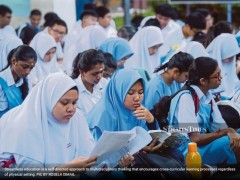Berita

Streamless education offers level playing field
Tarikh : 10 December 2019
Dilaporkan Oleh : Roslan Bin Rusly
Kategori : News
Tweet This
On reading in the media about the implementation of the streamless delivery last week, a number of scenarios emerged that could be problematic. Here are two.
SCENARIO 1
Urban euphoria. It is named such because urban schools have the most to gain from the new streamless approach to education announced recently.
Why not? Given their strategic locations by and large, urban pupils are within reach of many of the new subjects offered under the different packages.
Chances are many schools are relatively better equipped and resourced to meet the students’ expectations and demands. Even assuming that the schools are not able to meet the demands, there will always be other alternatives to lean on outside the school.
Allegedly, this is allowable as schools are given a degree of autonomy, taking into account the facilities and capabilities available.
For example, to enrol for the package on catering and hospitality, or sustainability for that matter, students can, in principle, transfer to another school that has what it takes to deliver the appropriate learning outcomes.
Otherwise, it could be a private setting to acquire the same. While the former seems acceptable being from the same ministry (read: in sync with each other), this cannot be said for the latter.
The obvious snag is that the private outlets are different and thus need to be certified or accredited before they can be recognised to offer any of the desired packages as stipulated by the ministry. This indeed is the rule of thumb in dealing with such situations nationally and internationally, in educational terms.
The question then: has this been adequately addressed to avoid ad hoc (mis)steps given there is less than a month to the new year when the “streamless” education is expected to be formalised?
To start with, there is a condition of a minimum of 15 students before a class could be convened. Does this apply all round?
Such an undertaking can be a logistical nightmare to get this organised, more so in quick time, sporadically.
Let alone to ensure the authenticity of the academic merits issued by such diverse alleged outlets spread all over the country. Failing which it can only result in a major row because the playing field is not level.
SCENARIO 2
Rural despair. There can be no closer truth to a non-level playing field than the second scenario.
It refers to the state of affairs in several constrained rural areas that are markedly disadvantaged in comparison with their urban counterparts.
As it stands, the disparities are well known on most fronts — facilities, human resources, availability and access to adequately prepared private alternatives.
Thus, unlike the first scenario, most likely the demands involving students in rural schools will be more uphill relative to the urban centres.
Indeed todate, even before the streamless idea comes into being, several of the usual packages then are found wanting. Hint: where are most of the reportedly dilapidated schools located? Need we say more.
In other words, the status of rural schools will be placed under greater pressure under the streamless scheme offering a multitude of elective packages.
Some require very specialised resources and capacities that are even harder to come by.
To hit the ground running come the next few weeks, the rural students could be seriously short-changed, where the ecosystem remains as it was and least prepared to cope with the massive changes.
If previously they were already on a non-level playing field, this time it will be worse.
To be sure, the move is unprecedented and cannot be left to trial and error as cautioned by professional bodies and individuals.
Interestingly, universities are lukewarm in their response thus far, despite likely becoming the largest recipient of these newly-minted streamless breed of students.
SO WHAT IS LEFT TO CONSIDER?
One way out is to look at the streamless idea as independent of the locale — urban or rural.
Rather, it is centred on students regardless of where they are located.
This is to decouple the exercise from uncertainty of resources and facilities through seamless learning instead.
Meaning, the emphasis is to bridge the different types of learning settings ranging from social to digital learning (like massive open online courses) across locations and experiences.
In itself, it is a self-directed approach to multidisciplinary thinking that encourages cross-curricular learning processes regardless of physical setting, intellectual and academic content and substance.
This will enhance the ability to connect as many dots as possible in the search for sustainable futures.
Students therefore are not only proficient in technological skills but also humanistic ones.
In this way, streamless education is moving away from fragmented learning (read packages) and is less tied down to location and uneven resource allocation, making it a more level playing field.
It implies that students can learn whenever they are curious in a variety of scenarios, switching academically from one to another. This is the ultimate new learning for the future, streamless and seamless.








